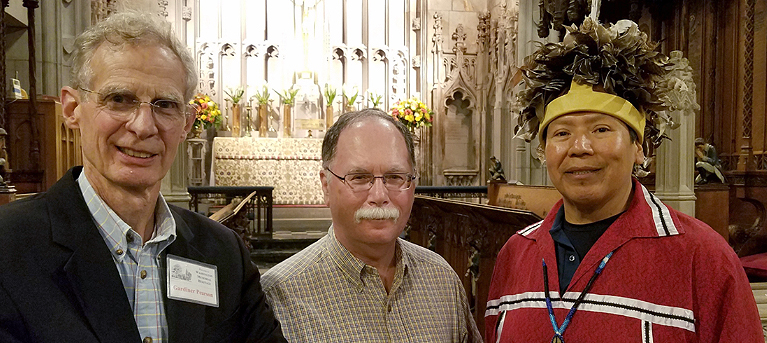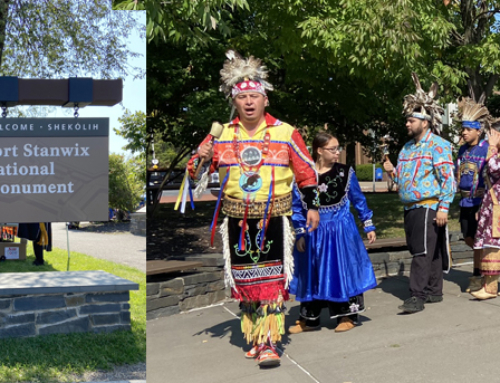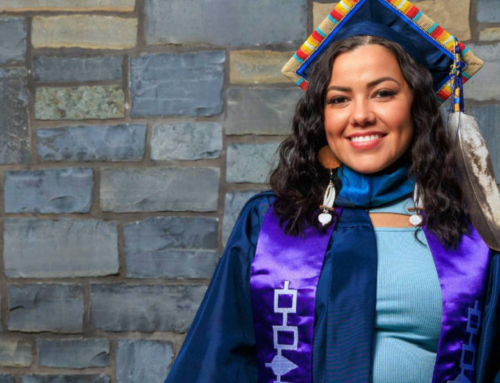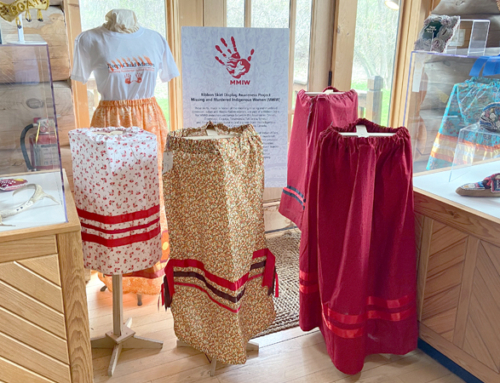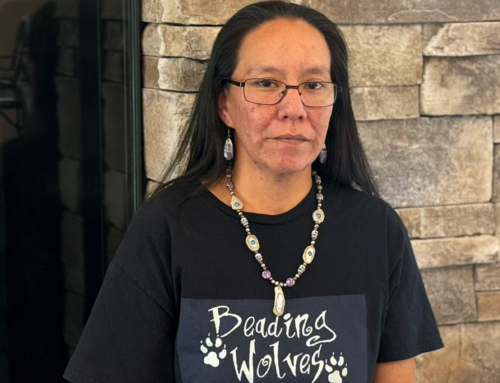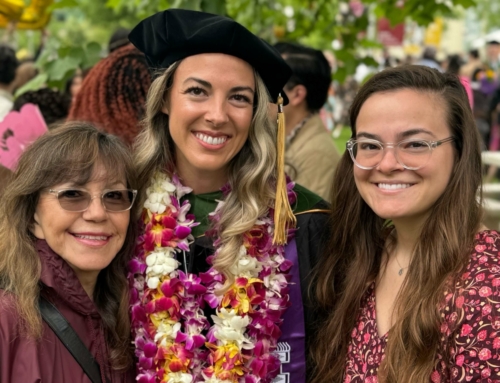Oneida Heritage Center Manager, Ron Patterson (Wolf Clan), has been one of the consistent voices of Oneida history over the last decade. With a deep knowledge of the Oneida culture, part of Ron’s job involves reaching and educating people about the lesser known stories that impacted not only the Haudenosaunee Confederacy, but also the formation of the United States.
Ron recently had the opportunity to visit Valley Forge and talk to a large, diverse group of over 100 visitors at the Washington Memorial Chapel interested in beginnings of the relationship between the colonists and the Oneidas. The event was part of the annual Speaker Series on the American Revolution sponsored in part by the Valley Forge Park Alliance. Valley Forge was the site of a military encampment for Gen. George Washington’s Continental Army in 1777 and 1778. This was where several Oneida, including Han Yerry and Polly Cooper, traveled with bushels of white corn to feed Washington’s starving troops at a critical time during the war.
The Washington Memorial Chapel’s mission is to honor George Washington and all of the patriots who were at the Valley Forge encampment of 1777-78. It is their sacrifices that ensured the survival and ultimate success of the American Revolution. While honoring these individuals, the Chapel also recounts the story of the founding of the United States and seeks to communicate the virtues of courage, sacrifice and commitment.
The remarkable journey of Cooper, Han Yerry and several other Oneida to the encampment is an excellent example of those virtues. It was the culmination of talks between Chief Skenandoa and Rev. Samuel Kirkland attempting to convince the Oneidas to aid the American rebels. But the visitors to the Chapel this past October wanted to know more about that crucial decision. Why would the Oneidas choose to help the colonists and oppose their Haudenosaunee brethren?
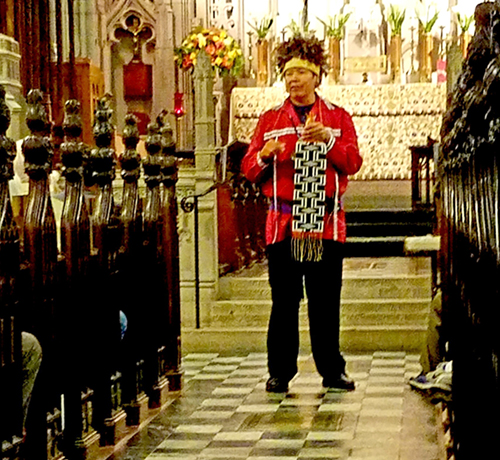
Ron Patterson holding a replica of the Oneida Indian Nation belt.
To tell the story from the Oneida perspective, Ron brought with him three replica wampum belts – the Hiawatha, Two Row, and Oneida. The belts are a tangible, visible explanation of the historic and sacred agreements made with the newcomers to Native lands. When beads were collected into strands or woven together as belts, the wampum stood for the authority of a spoken message.
The first belt is named after Hiawatha, the Peacemaker’s helper. It is the record signifying when the five nations – the Seneca, Cayuga, Onondaga, Oneida, and Mohawk – buried their weapons of war to live in peace. The Great Law of Peace inscribed in the belt was a type of social organization among the Nations, similar to a constitution, which binds all of the Nations together.
During the later 1600s when Dutch explorers encountered the Haudenosaunee, an agreement was made and represented in the Two Row belt, which depicted how each were to treat each other and live together. Their ways of life were woven in two purple rows, traveling down the river of life side by side without either attempting to steer the other’s vessel.
The belts are symbols of the eternal bonds of the Haudenosaunee, which ultimately led to the fateful decision of Chief Skenandoa and the Oneidas to oppose their brothers and sisters that sided with the British, and instead support the colonists’ fight for freedom. The Oneida belt, assembled in the early 1720s, welcomed the Tuscaroras to the Haudenosaunee Confederacy.
As the ‘People of the Longhouse,’ the Haudenosaunee Nations were connected by nine families, known today as clans. The Oneida Indian Nation has three clans: turtle, wolf and bear. The bonds between each were deep and generations-old, so Chief Skenandoa’s decision was met with intense fervor from the originalists that did not want to be pitted against their families.
Ron informed the gathered guests about that historic decision, stating how Chief Skenandoa befriended the missionary Rev. Samuel Kirkland, the most instrumental person in gaining the Oneidas’ support. It was religion – specifically Christianity – that tied the two together. He said Kirkland even translated the Bible to the Oneida language, which cemented their strong relationship moving forward.
“It’s all about understanding your history,” Ron said recapping his talk. “After the war, the United States recognized our individual Nations and their sovereignty with historic treaties, but the Haudenosaunee Confederacy never regained its continuity from before European settlers came to our lands.”
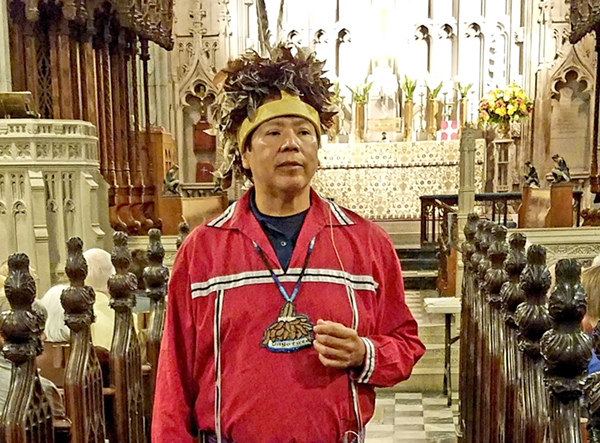
Ron Patterson discusses Oneida history with visitors to the Washington Memorial Chapel in Valley Forge.
Gardiner Pearson, a representative of Washington Memorial Chapel that organized Ron’s visit, aims to find people that can tell stories that are often unknown or underappreciated.
“In these talks, we try to provide interesting insights into the events of the times,” he said. “Few people are aware of the participation and contribution of the Oneida either at Valley Forge or in the other campaigns and battles of the Revolution. We thought that story would be of interest to our audience and invited a representative of the Oneida Indian Nation to give the first talk of the 2018-2019 season.”
The audience was fascinated to learn about the structure of Oneida society, its political foundations and traditions, the significance of the various wampum belts and the importance of the Haudenosaunee Confederacy.
“It was extremely important for our audience to learn not just about the Oneida contribution to the American War for Independence, but also about the social and political structure of the Oneida people and the wrenching consequences of the difficult decision they made to side with the American cause,” Gardiner said after Ron’s visit.
The Great Law has survived and stayed with the Oneida people for centuries. Ron’s description of the Great Law’s concepts and the importance of the wampum belts helped the visitors understand how the Haudenosaunee people live and behave.
Ron is glad to get a number of opportunities to speak and engage with audiences across the northeast that are interested in the Haudenosaunee story and its impact on the American Revolution. It’s been a critical component to the Shako:wi Cultural Center and Oneida Heritage Center, ensuring the whole story is told faithfully and accurately. Ron is hoping to put a greater focus on the exhibits and original artifacts at each facility.
“We want to bring more reality to the face of the cultural centers,” he said. “We want to provide some of the real, authentic pieces we have for Members, and the general public, to learn our true story.”


